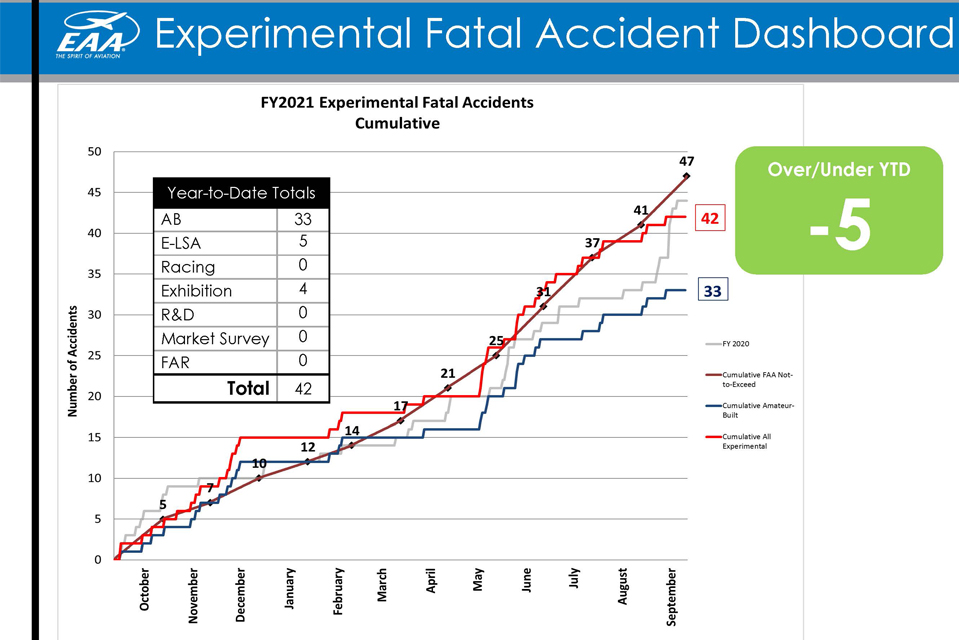Spread Your Wings at AirVenture
Experimental category fatal accident total drops again, finishes under faa not-to-exceed total for year, fatal accident totals have fallen 40 percent in past decade.


Recent Articles
November 13, 2024
November 12, 2024
November 07, 2024
November 01, 2024
October 17, 2024
EAA AVIATION CENTER, OSHKOSH, Wisconsin — (October 28, 2021) — Safety for experimental category aircraft in the U.S. over the past 12 months continued the trend of improvement seen over the past 15 years, as the fatal accident total fell another 5 percent and finished below the Federal Aviation Administration not-to-exceed number for the federal fiscal year ending September 30, 2021.
This decrease in fatal accidents mirrors a year of substantial improvement in overall general aviation, even with increased flight hours over the past 12 months. There were 42 fatal accidents in experimental category aircraft during that period (October 1, 2020-September 30, 2021), five below the FAA’s not-to-exceed number set for the year. Of that total, 33 were in amateur-built aircraft.
“This is continued good news on the safety front, as fatal accident totals in the experimental category have fallen 40 percent in the past decade,” said Sean Elliott, EAA’s vice president of advocacy and safety. “Fatal accidents in homebuilt aircraft have dropped by one-third over that time as well, reflecting a safety culture that is more widely accepted and followed as an important part of the balance of freedom and responsibility that is such an essential element of flying.”
The FAA has continued to lower the not-to-exceed total each year as an expectation for improving the safety metrics throughout aviation. The agency first set a goal in 2010 of reducing the fatal accident total by 10 percent over the next decade, a target that was quickly surpassed and set the stage for even more dramatic improvements in the safety measurements.
EAA continues to focus on safety and is actively working with FAA with such groundbreaking programs as Additional Pilot Program, the EAA published Flight Test Manual, and the upcoming task based flight test allowance for phase I flight testing of certain homebuilt aircraft. MOSAIC as a new baseline for recreational aircraft will also enable many safety-enhancing elements for both aircraft and pilot certification in the EAA community. Safety continues to be a central focus for EAA and its communities.
“As positive as these figures are, EAA will not stop here and will continue to lead in making safety the top priority for all of us who fly,” Elliott said. “We have pushed the totals to very small numbers than are substantially fewer than many other common recreational pursuits, such as boating or all-terrain vehicles. But with such small numbers, even one or two accidents can have a negative impact on the overall safety trend.”
EAA embodies The Spirit of Aviation through the world’s most engaged community of aviation enthusiasts. EAA’s 230,000 members and 900 local chapters enjoy the fun and camaraderie of sharing their passion for flying, building and restoring recreational aircraft. For more information on EAA and its programs, call 800-JOIN-EAA (800-564-6322) or go to www.eaa.org . For continual news updates, connect with www.twitter.com/EAA .
EDITOR’S NOTES: Illustrations of accident rate month-to-month and vs. FAA not-to-exceed number at EAA media resources website: https://eaaosh.sharepoint.com/sites/media ID: [email protected] PW: E@@-Pix4U
Additional safety studies from other common recreational pursuits:
- Motorcycle/bicycle deaths: https://www-fars.nhtsa.dot.gov/Main/index.aspx
- Recreational boating deaths: https://www.uscgboating.org/library/accident-statistics/Recreational-Boating-Statistics-2020.pdf
- Skiing/snowboarding deaths: https://nsaa.org/webdocs/Media_Public/IndustryStats/fatality_fact_sheet_2020-21.pdf
- ATV deaths: https://www.cpsc.gov/s3fs-public/2018AnnualReportofATVRelatedDeathsandInjuries.pdf?VGaf1cuZ_D0SGxct2eRpZUwcgME4LKDy

IMAGES
VIDEO